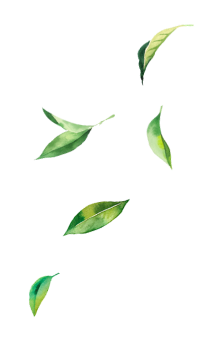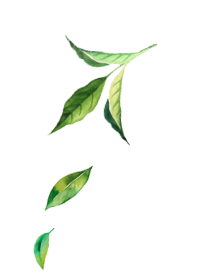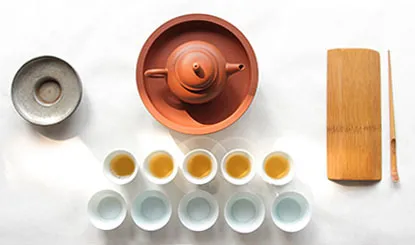




Tea Culture - A Brief History of Chinese Tea Drinking

Without culture, tea is just a leaf.
By / Specialist Lin, Pei-Chi, Human Resources Department
Published in / December 2017, 9th Issue of “Chunshuier”
Through the selected highlights of the history of tea drinking in China, let's navigate through the river of history together and see how the Chinese people in each era enjoyed the pleasure of drinking tea.
Approximately 60-70 Million Years Ago
First, let's go back to around 60-70 million years ago. According to research on plant taxonomy, tea trees (Camellia sinensis) appeared in the southwestern part of China, in the Yunnan and Guizhou regions.
Around 5000 BCE
Moving forward to around 5000 years ago, it is said that humans began to use tea at this time.
Even before the emergence of oracle bone inscriptions, ancient tales passed down through generations recounted the legend of Shennong, who experimented with various herbs. According to the legend, he accidentally poisoned himself but was miraculously cured by consuming tea leaves.
547-490 BCE (Spring and Autumn Period, Warring States Period)
During the era when Confucius spread Confucianism, tea leaves were predominantly utilized for medicinal purposes. Over time, they began to be incorporated into offerings for ceremonies honoring heaven, earth, and ancestors. Additionally, people experimented with cooking tea leaf porridge.
Does this sound appealing to your palate? Why not give it a try and discover if you develop an affinity for this distinctive culinary creation?
Recipe:
1. Boil ginger to make the base for the porridge.
2. Cut dried orange peel into shreds and boil them with tea leaves in the porridge.
3. Use coriander and spring onions for flavoring.
4. Serve and enjoy!
206 BCE (Western Han Dynasty)
In the Western Han Dynasty, a man named Wang Bao authored the first recorded labor contract in Chinese history. This document mandated that household servants were responsible for “meticulously preparing tea” and “procuring tea from Wuyang”. Have you noticed the key points?
Key point 1: Tea drinking already had dedicated tea utensils.
Key point 2: There was a tea market in Wuyang, indicating that tea had become a deliberately cultivated economic crop.
220-589 CE (Wei-Jin-Northern and Southern Dynasties)
Also known as the Three Kingdoms, Two Jin, Northern and Southern Dynasties period was marked by about 400 years of turmoil in Chinese history. Political instability was rampant, and people experienced a sense of unrest. Buddhism gained significant prominence during this time, deeply influencing the populace. In the book “Record of Buddhist Temples in Luoyang” (洛陽伽藍記), there are many articles about temple tea drinking. In addition, the legend of “Lei Cha” (擂茶) was also invented and spread during this period.
According to legend, during the Three Kingdoms period, when Zhang Fei was besieging Wuling, his soldiers fell ill and were unable to continue the attack due to an epidemic. An elderly villager, moved by the Shu army's discipline, shared a secret recipe passed down through generations. He ground raw tea, raw ginger, and raw rice into a paste for the soldiers to consume, and miraculously, all the soldiers recovered from their illnesses! Lei Cha began to spread from this time onwards.
581-618 CE (Sui Dynasty)
With the completion of the Grand Canal, trade flourished. Southern goods flowed northward, and the habit of drinking tea gradually spread northward.
618-907 CE (Tang Dynasty)
During the Tang Dynasty, China emerged as a global powerhouse, exerting considerable influence across domains like science and technology, culture, and politics and diplomacy. Its prosperity attracted numerous foreign traders and students, fostering exchange and learning. Among these visitors were Japanese monks who studied tea and its ceremonies in China, subsequently introducing tea seeds and tea culture to Japan. This marked the inception of tea-drinking traditions in Japan, influenced by the rich tea culture of Tang China.
During this era, which was characterized by cultural exchange and openness to diverse influences, Lu Yu championed the idea of appreciating tea in its purest form. He advocated against adding any seasoning except salt, emphasizing the intrinsic essence of tea. His seminal work, the “Classic of Tea” (茶經), stands as the first professional book on tea in human history, meticulously outlining the production and consumption techniques of tea leaves while delving into the ideal settings for tea enjoyment. Even today, over a thousand years later, we can glean insights into how ancient people savored their tea from Lu Yu's writings.
960-1279 CE (Song Dynasty)
The Song Dynasty was the world's leading technological power at the time. Renowned for its inventions such as the compass, gunpowder, and movable type printing, the dynasty also excelled in various crafts, including silk production, metallurgy, ceramics, and navigation technology, setting global standards in these fields. The dynasty's remarkable advancements attracted numerous foreign students and merchants, fostering vibrant cultural and commercial exchanges. As a result, the Song Dynasty thrived with prosperous trade activities, solidifying its status as the wealthiest dynasty in China.
In addition to science and technology, the Song Dynasty also had a very high level of cultural refinement. Cultural and artistic development flourished, including poetry, ci (a type of lyric poetry), calligraphy, seal carving, and painting. People's lives were diverse and elegant, with night markets, snack shops, and teahouses everywhere in the city.
In his book “A Dream of Sorghum”, Wu, Zi-Mou vividly described the business model of teahouses during that era, particularly in Hangzhou. He depicted them as “establishments adorned with seasonal flowers and adorned with famous paintings. Flower racks were strategically placed to showcase rare woods like exotic pines and unusual cypresses, enhancing the ambiance. These teahouses offered a variety of unique teas and soups year-round, with specialties such as seven treasures pounded tea or salted soybean soup in winter, and refreshing options like snowflake plum wine in summer”. As an employee of Chun Shui Tang, you must know that our business style and architectural installation art are derived from this.
In the Song Dynasty, tea drinking reached new heights of refinement and intrigue. In the Beiyuan Gongcha region of Jian'an, which is situated in present-day Fujian, tea artisans engaged in a meticulous routine during springtime. Rising before dawn, they carefully plucked tender tea buds under the early morning sun. These freshly harvested buds were then subjected to intricate processes to create small tea cakes, meticulously crafted for long-term storage. These small tea cakes, adorned with intricate dragon and phoenix motifs, boasted exceptional quality but were crafted in limited quantities. Unless bestowed as a favor by the emperor, acquiring them proved challenging for the common populace. Ouyang Xiu, as cited in “Returning to My Old Fields” (歸田錄), remarked: “A single Longtuan tea cake, weighing twenty cakes to a catty, holds a value equivalent to two taels of gold. While gold may be attainable, tea is not”. Twenty tea cakes make up one catty, and each cake costs two taels of gold. In today's gold prices, a pound of tea is worth approximately NT$760,000. This shows how precious tea was at that time.
In the lively and prosperous society of the Song Dynasty, how did people enjoy tea?
Before brewing tea, they would gently roast the tea cakes over a low flame, let them cool, then crush and grind them into fine tea powder, which was then sieved. The tea powder would be placed in a black pottery bowl, mixed with water, and whisked with a special bamboo brush (tea whisk). If they could create a layer of dense foam on the tea's surface, they were considered to have mastered the basics. However, to be recognized as a true master, they needed to practice diligently until “they could create patterns on the surface of the tea resembling various objects, such as animals, insects, fish, flowers, and plants, delicately drawn like paintings”. This technique of drawing on the bubbles of the tea soup was called “Tea Hundred Performances” (茶百戲).
This intriguing method of brewing tea in a bowl was also introduced to Japan by Japanese monk students. It eventually evolved into the symbolic cultural expression of Japan known as the “Way of Matcha” (抹茶道).
1271-1368 CE (Yuan Dynasty)
In an era of chaos and upheaval, although the Yuan Dynasty's reign was short-lived and did not significantly influence China's tea culture, Genghis Khan (Temujin) established a superpower that spanned Eurasia, bringing tea to distant lands. It is said that the tea-drinking customs in regions such as Russia, Persia, and the Mediterranean originated from this time.
1368-1644 CE (Ming Dynasty)
With frequent political upheaval and escalating ethnic conflicts, the Yuan Dynasty saw numerous peasant uprisings. Upon seizing power, Zhu, Yuan-Zhang faced the dire circumstances of the people and implemented various policies to restore national strength. One significant change he enacted was the transformation of China's tea-drinking culture from “compressed tea cakes” to “loose-leaf tea”. This brought about notable shifts in tea processing techniques and drinking methods.
Before the Ming Dynasty, only steamed green tea was produced, and during the Tang and Song Dynasties, tea was fashioned into compressed tea cakes. However, during the Ming Dynasty, under the imperial decree, loose-leaf tea became prevalent, and the “panning” (炒青) method was introduced, now classified as the “green tea category” among the six major types of tea leaves.
The appearance of tea leaves transitioned from compressed cakes in the Tang and Song Dynasties to loose leaves during the Ming Dynasty, eliminating the need to grind them into tea powder. This transformation also influenced the form of tea utensils, with the familiar “teapot” emerging during this period.
During the Ming Dynasty, amidst its flourishing literary atmosphere, scholars did not simply toss a handful of tea leaves into a teapot and pour water. What were their considerations when drinking tea?
Firstly, they prioritized creating an ambiance. Drinking tea in an elegant setting allowed these literati to feel inspired and let their thoughts flow freely. Ideally, they would establish a tea pavilion near renowned river springs and unique rock formations. If possible, they would burn incense, play the zither, appreciate paintings, and savor tea. Life in such moments would be truly beautiful! This led to the emergence of numerous tea studies throughout the ages, delving deeper into tea quality, teapot appreciation, water usage, and tea brewing methods.
In Zhang Yuan's “Tea Record” (茶錄), the section on “Liquid Distinction” describes observing the appearance of boiling water, comparing it to shrimp eyes, crab eyes, fish eyes, and then to roiling waves, illustrating the importance of visually assessing water temperature when brewing tea. The section on “Tea Infusing” (投茶) emphasizes the significance of orderly tea pouring according to the season and temperature, outlining three methods: bottom pouring (adding tea leaves before pouring water), middle pouring, and top pouring; and it also advises on the appropriate amount of tea to use, avoiding bitterness from excess tea or a weak flavor from too little. These brewing techniques remain practical to us today.
1644-1912 CE (Qing Dynasty)
Following the reigns of Emperors Kangxi, Yongzheng, and Qianlong, China's national strength once again reached its zenith. Tea production techniques matured, and the six major tea categories (green, yellow, white, oolong, black, and dark tea) gradually became well-established.
During this period, tea production regions multiplied, and tea drinking became widespread among the populace. Each region had distinctive characteristics. The Manchu nobility favored jasmine tea, while the people of Hangzhou enjoyed Longjing tea. In Xinjiang and Mongolia, they preferred milk tea, while residents of coastal areas leaned towards Gongfu tea served in small pots, known for its strong aroma.
The Qing Dynasty was the heyday of teahouses, serving as significant gathering places for citizens. The class distinctions associated with tea drinking gradually dissolved, as aristocrats conversed with vendors and the affluent befriended beggars over a fine teapot. Due to this passion for tea and appreciation of exquisite teaware, the craft of Yixing clay teapot making reached its zenith during this era.
However, the aroma of tea unexpectedly attracted trouble. Britain spent vast sums to purchase high-quality tea from China, leading to a severe trade deficit that incited the “Opium Wars” between China and Britain, and even sparked the largest commercial espionage event in history. After the defeat, China's dominance in the tea industry never fully recovered.
Exploring the history of tea drinking in China, we understand how tea was discovered and utilized. Despite the diverse living conditions and unique cultural backgrounds of each dynasty, the common thread is the love for tea.
Some people drink tea to quench their thirst, others use its properties to regulate their bodies, some use tea to cultivate their minds, and there are those who use tea to befriend others or to express their sentiments. Despite being just a plant, tea has never disappeared from the “most beloved beverages by humans” list over thousands of years, which is truly remarkable.
Has learning about the history of tea drinking through the ages sparked more curiosity in you?
Stay tuned for more from “Exploring Tea Culture”!







